Brian Dean – Advanced Link Building

This is a complete guide to link building in 2022.
So if you want to build authority backlinks to your website, you’ll enjoy the actionable tips in this new guide.
Let’s dive right in.

CHAPTER 1:Link Building Fundamentals

In this chapter I’ll answer the question: “What Is Link Building?”.
I’ll also show you why link building is still important for SEO in 2022.
Let’s get started.
What Is Link Building?
Link building is the practice of building one-way hyperlinks (also known as “backlinks”) to a website with the goal of improving search engine visibility. Common link building strategies include content marketing, building useful tools, email outreach, broken link building and public relations.
Why Are Links So Important?
To understand that, you’ll need to hop in your Delorean and go back to the pre-Google days of the internet.
Back in the day, search engines like Yahoo! and Alta Vista were the dominant players. And they ranked their search results 100% based on the content on a webpage.
Enter: Google.
Their now-famous PageRank Algorithm changed the game. Instead of simply analyzing the content of a page, Google looked at how many people linked to that page.

And they were right. Nearly 20 years later, links are STILL the best way to determine the quality of a webpage. That’s why backlinks remain Google’s go-to ranking signal.
That said, thanks to updates like Google Penguin, Google now focuses on link quality (not just link quantity).
You might be wondering:
What is a high-quality link, exactly? And how do I build them?
That’s what I’m going to cover in the next chapter.
Keep reading…
CHAPTER 2:How to Find High-Quality Links

Before we dive into the step-by-step link building strategies, it’s important to know what makes a good (or bad) link.
That way, you can focus on building links that will actually improve your Google rankings.
With that, here’s how to identify links that are actually worth building:
Authority of the Page
Is the page linking to you a PageRank powerhouse? If so, that link is going to have a BIG impact on your rankings.
In fact, from years of testing, I’ve found that the authority of the page linking to you matters more than any other factor.
That’s because links from authoritative pages pass more authority (also known as PageRank) to your site.
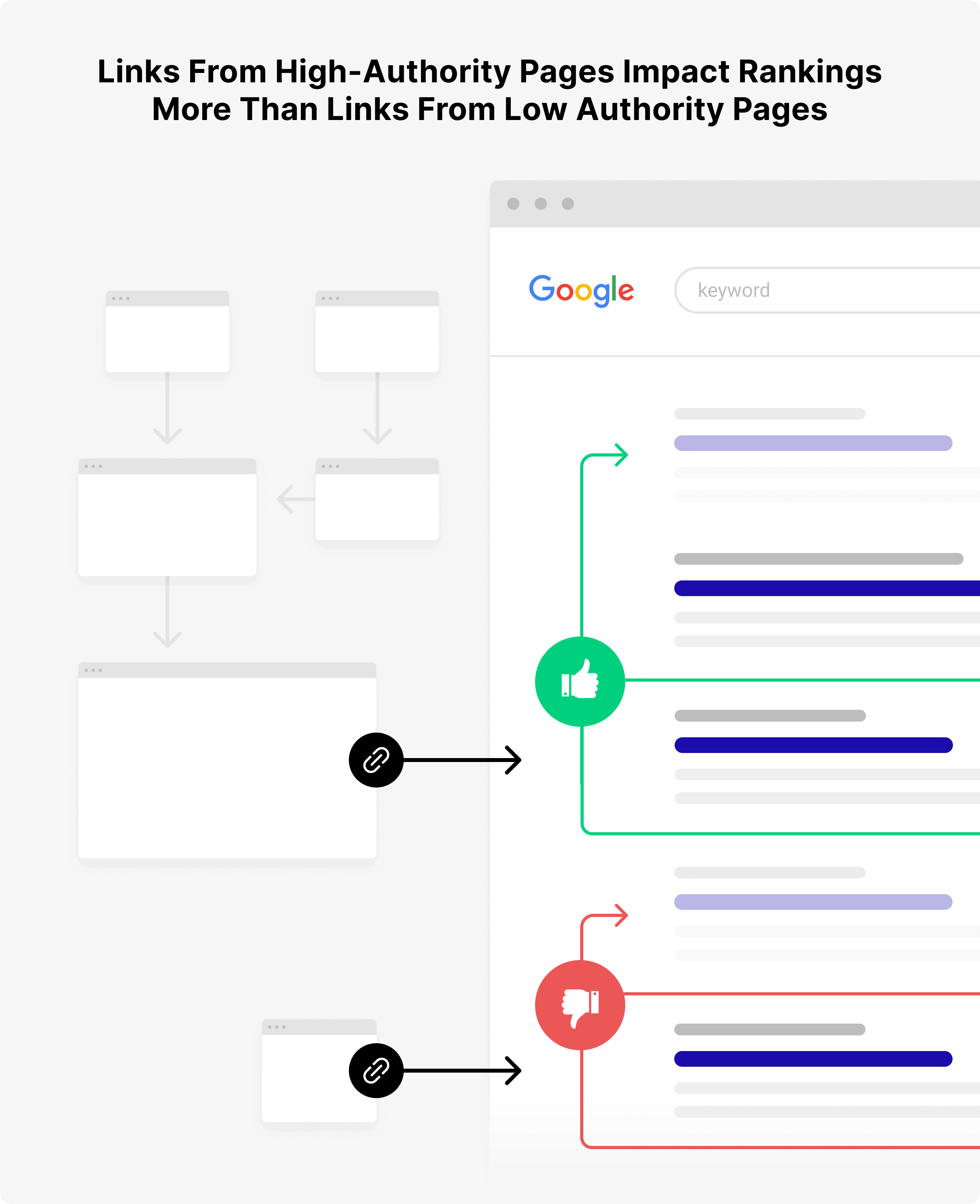
(Note: Although Google doesn’t share PageRank information publicly, they still use it as the foundation of their algorithm.)
You can easily check a proxy indicator of PageRank (“PageRating”) using Semrush.
Just pop a URL into Semrush and check out its “Page Authority Score”:
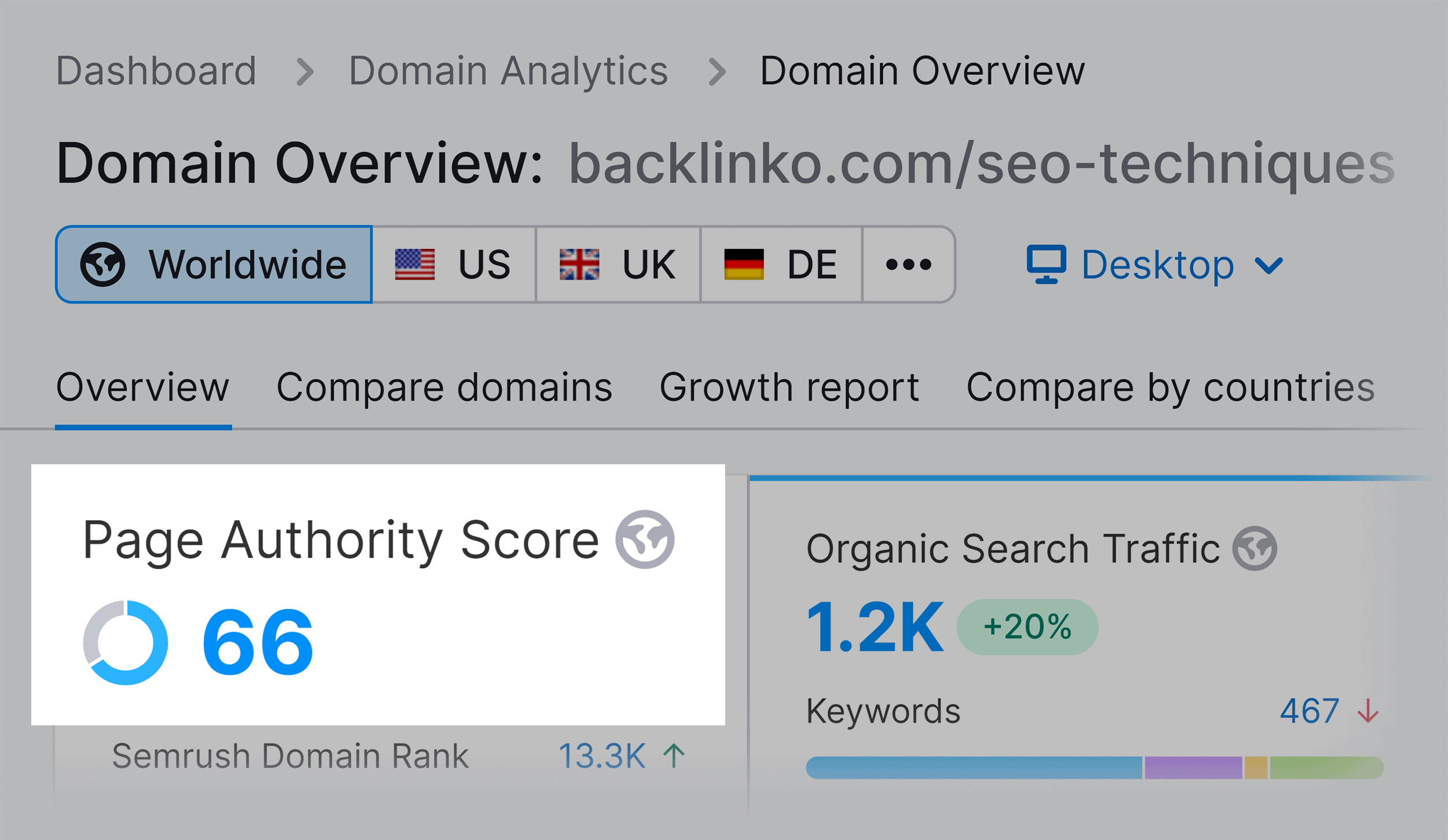
Authority of the Site
A link’s quality is also determined by a domain’s sitewide authority.
In general, a link from a site like NYTimes.com will have a MUCH bigger impact than a link from a no-name blogger.
While these links are tough to get, they’re well worth the effort.
Again, Semrush comes in handy here. Enter a site root URL into the tool and check out its “Authority Score”.
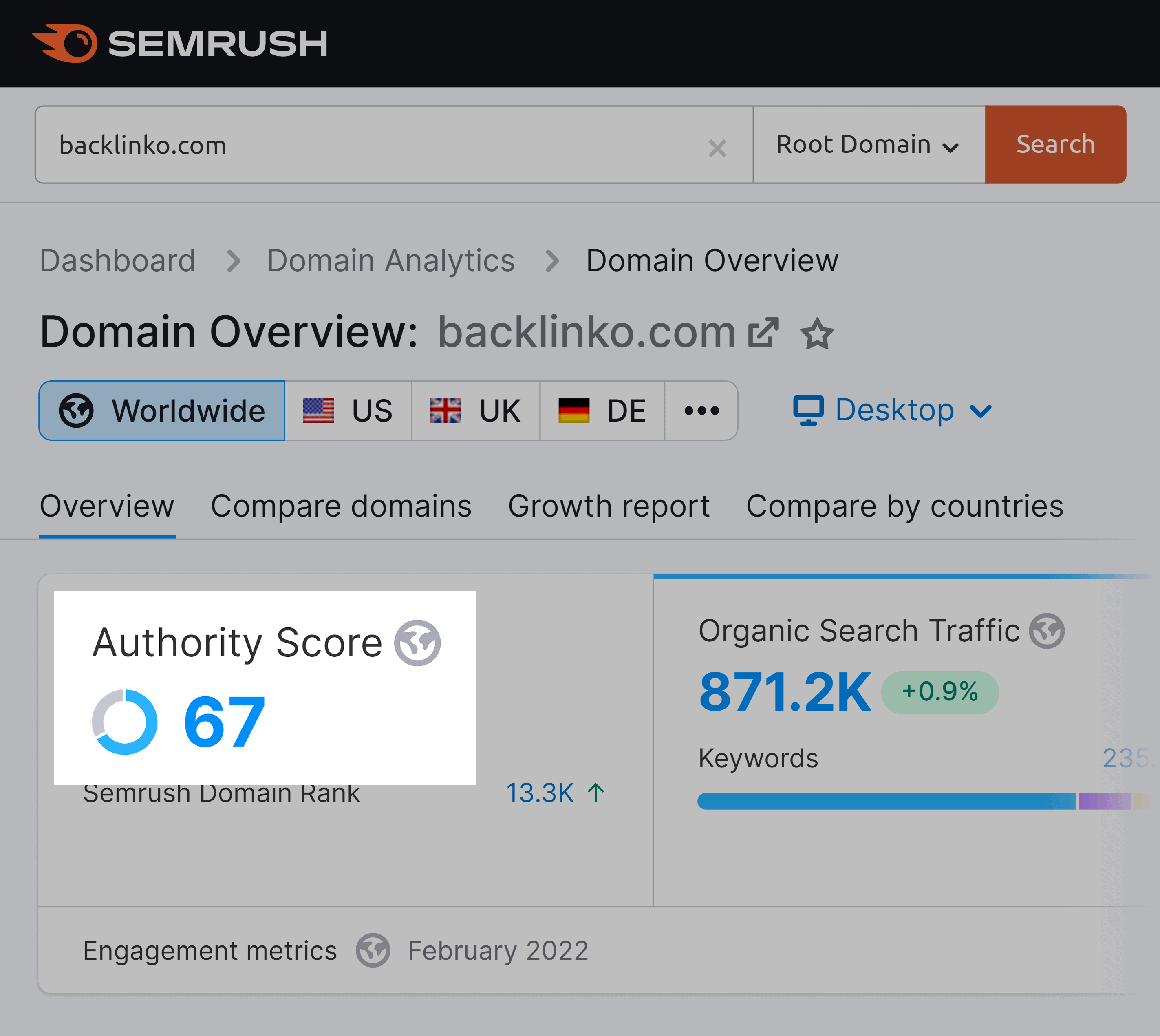
Relevancy of the Site
When it comes to links, a site’s authority matters.
But that site’s relevance also matters.
For example, let’s say you run a website about The Paleo Diet.
And you get a link from an authoritative site… about unicycles. Will that link still count?
According to an interview from an ex-Googler, not really.
According to that Google engineer:
“…getting a link from a high PageRank page used to always be valuable, today it’s more the relevance of the site’s theme in regards to yours, relevance is the new PageRank.”
In general, you want to get links from authority sites…specifically, authority sites that are closely related to your site.
Link’s Position on the Page
Is your link embedded in a piece of content?

Or is it buried in a page’s footer?

It turns out that your link’s position on a page is important.
Specifically, links stashed away in footers and sidebars aren’t worth nearly as much as links found smack in the middle of a page’s body content.
Bottom line? You want your links to appear within the main body of a webpage.
Is the Link Editorially Placed?
No matter where your link appears on a page, you should ask yourself:
“Was this link editorially placed?”.
In other words, did someone link to you because they thought your site is awesome? If so, that’s an editorial link.
Or did you create a profile on a random site and drop a link? That’s not an editorial link.
As you might expect, Google puts MUCH more weight on editorially-placed links.
Quoth thy Google:
“…creating links that weren’t editorially placed or vouched for by the site’s owner on a page, otherwise known as unnatural links, can be considered a violation of our guidelines.”
Link Anchor Text
Anchor text is the clickable text section of a link.
As it turns out, Google uses anchor text as a ranking signal.
For example, let’s say you get a link to your site with anchor text: “paleo desserts”.
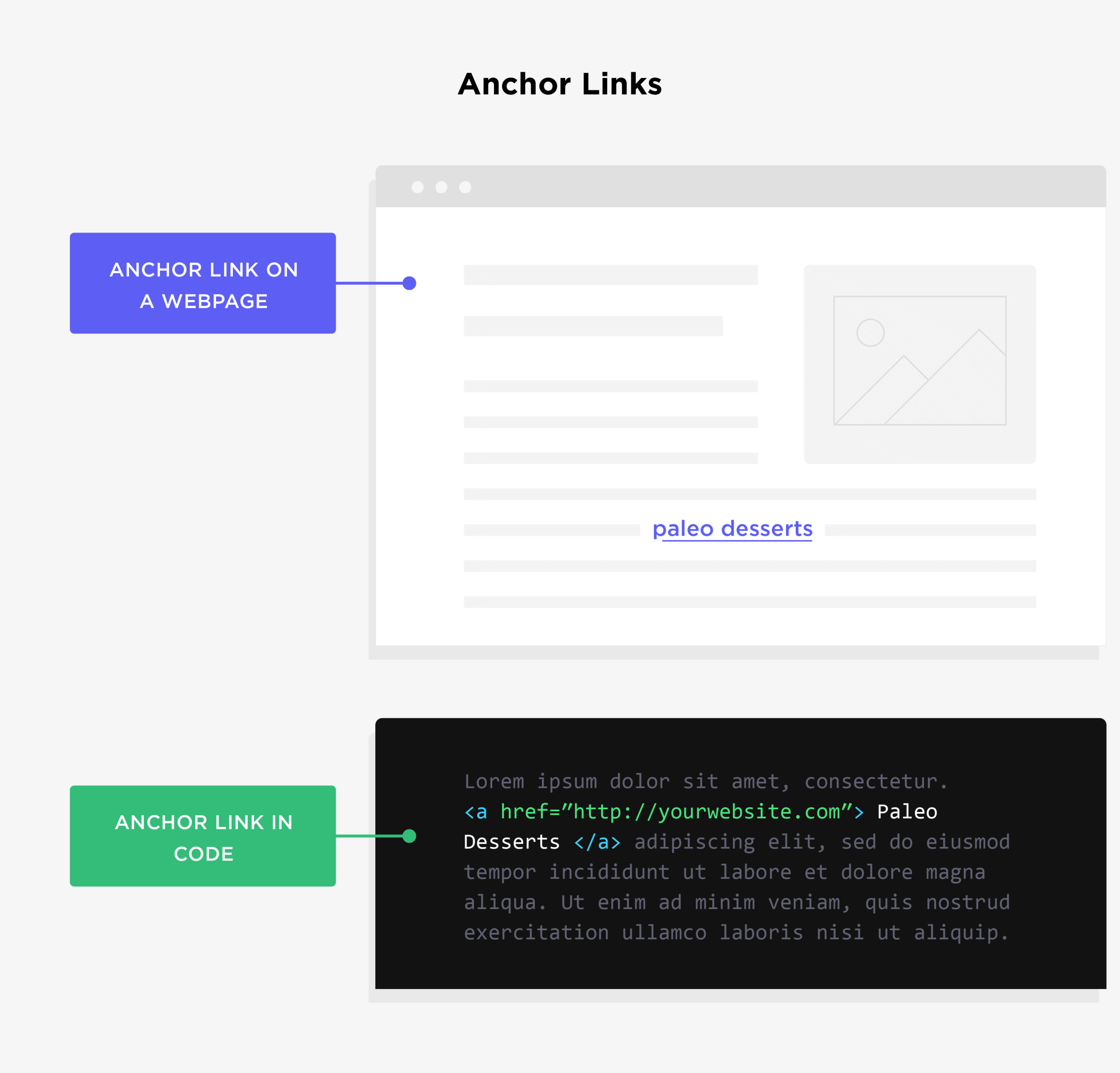
Google sees that anchor text and says: “Hmmm. That site used the anchor text: “paleo desserts”. The page they’re linking to must be about “paleo desserts.”
Of course, like anything in SEO, keyword-rich anchor text has been abused. Today, building lots of exact-match anchor text links is considered spammy.
Here’s an example of what I’m talking about:

In short, I don’t recommend building links with keyword-rich anchor text. But if you DO get a link with your keyword in the anchor text, it’s time to celebrate.
Link Co-Occurrences
Co-Occurrences are the words and phrases that appear around your link.
Google likely uses co-Occurrences as “baby anchor text”.
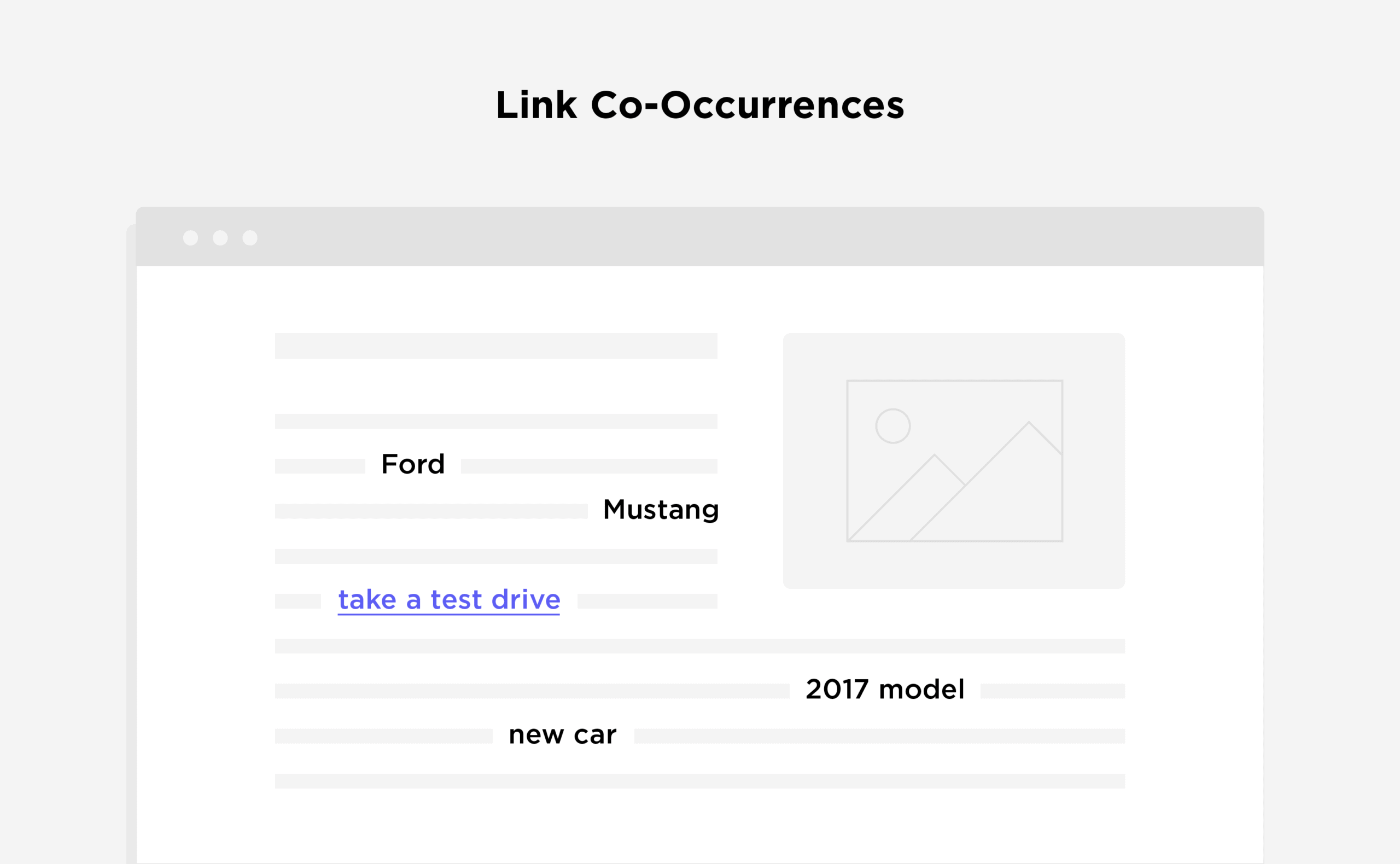
This makes sense if you think about it:
The text around your link also gives clues to what your page is about. So why wouldn’t Google use it?
Is the Link From a Guest Post?
A few years ago, Google came right out and said:

“So stick a fork in it: guest blogging is done; it’s just gotten too spammy.”
– Matt Cutts, Former Head of Google’s Webspam Team
Is that true?
Well…it depends.
Here are some red flags that can make guest posting spammy:
- Someone is paid to publish the post
- The post contains exact match anchor text
- The site exists solely to publish guest posts
- The site is unrelated to yours
But what if you publish a mind-blowing guest post on an authoritative, relevant site? In my experience, that link CAN help you rank.
Nofollow .vs. Dofollow
rel=”nofollow” is a tag added to a link that tells search engines: “Don’t count this link as an endorsement.”.
Obviously, when it comes to SEO, you want to get normal, “dofollow” links whenever possible.
Now that you can know how to size up a link’s quality, it’s time to start building them.
CHAPTER 3:How to Get World-Class Links With Content Marketing

Its no secret that content is the key that unlocks amazing backlinks.
But here’s the deal:
Simply publishing content isn’t going to land you any links.
As it turns out, certain types of content work best for link building.
And here are the 4 types of content that tend to generate the most links:
#1: Visual Assets
What It Is:
Visual assets are:
- Images
- Diagrams
- Infographics
- Charts and other visual-oriented pieces of content
Why It Works:
Visuals are super-duper easy to link to. For example, when you publish a chart on your site, you get a link anytime someone shares that chart on their site. This powerful “share my image and link to me when you do” relationship simply doesn’t work for text-based content.
Real-Life Example:
A few years ago I published this visual about Google CTR on my site.
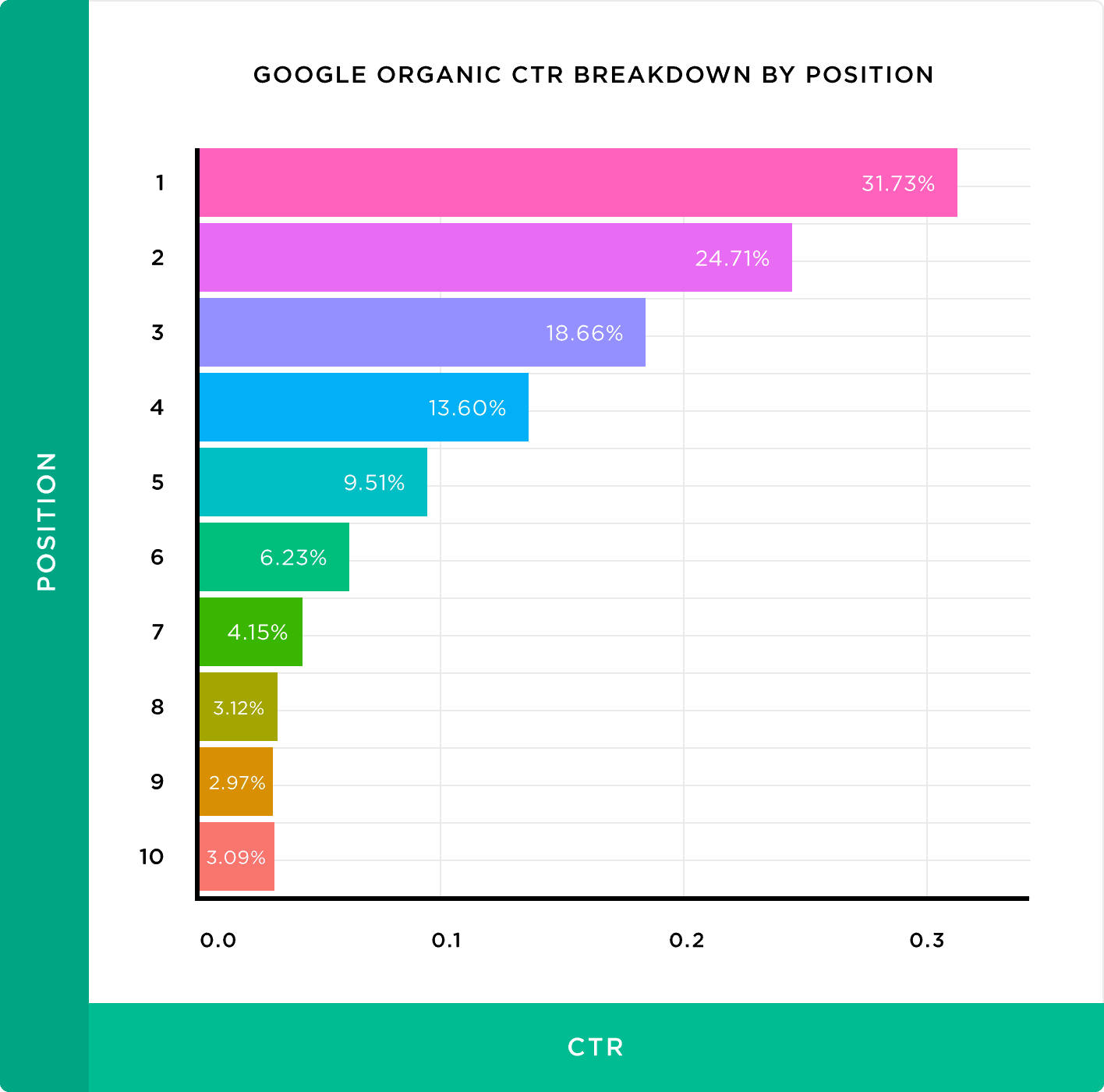
To date, this visual has been linked to dozens of times (many of which came from authoritative sites in the marketing niche).
Sure, some of these links would have come in even if I had listed the same data in a table.
But a good chunk of these links (I’d estimate 75%) were created because I presented the info as a visual.
In fact, lots of my links came from people directly posting my visual on their site (and linking back to me as the source):

And the funny thing is, even though it’s now 2022, people STILL link to my visual every month. That’s the power of creating visual assets.
#2: List Posts
What It Is:
A numbered list of tips, techniques, reasons, myths…or just about anything.
Why It Works:
List posts pack a ton value into digestible, bite-sized chunks.
In fact, when BuzzSumo analyzed 1 million articles, they discovered that list posts generated more backlinks than other content formats… outperforming quizzes, videos and even infographics.

Real-Life Example:
This list post, 19 NEW SEO Techniques For 2022, is one of my all-time most popular pieces of content.
Yes, it’s generated a ton of shares…

…and comments.

But most importantly, that post is a link magnet.
It has over 4,000 links.

And because the page has so many links pointing to it, it ranks in the top 5 for the keyword “SEO Techniques”.
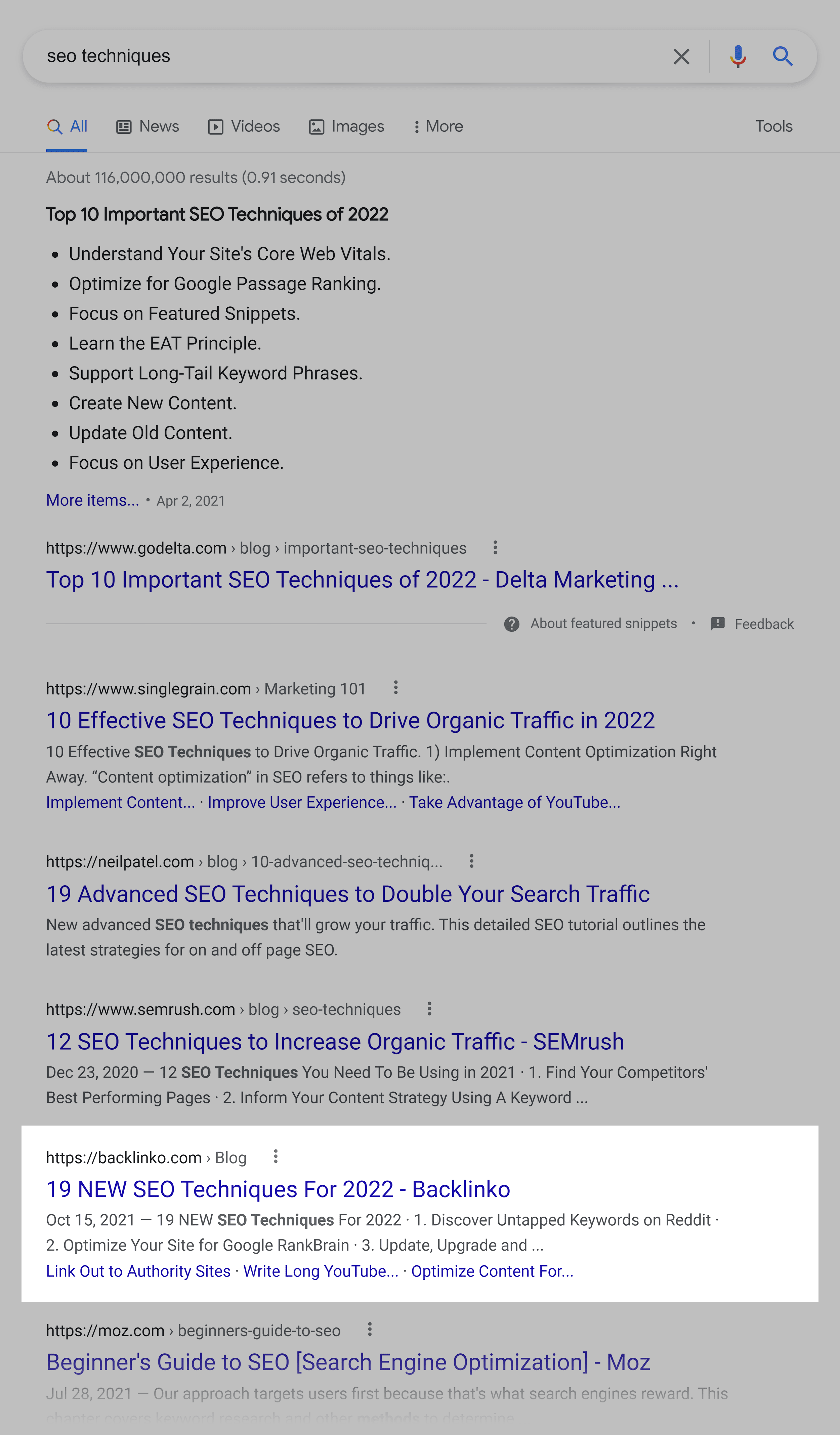
#3: Original Research and Data
What It Is:
Content that reveals new data from industry studies, surveys or original research.
Why It Works:
Statistics and data are highly linkable. When someone cites your data, they link to you. These links add up QUICKLY.
Real-Life Example:
Some time ago, I published the largest Google ranking factors study ever.

Needless to say, this post contains a boatload of original data.
That’s why the post has accumulated a whopping 18.9k links so far.

Like I mentioned above, most of these links come from people citing a particular statistic from our study:
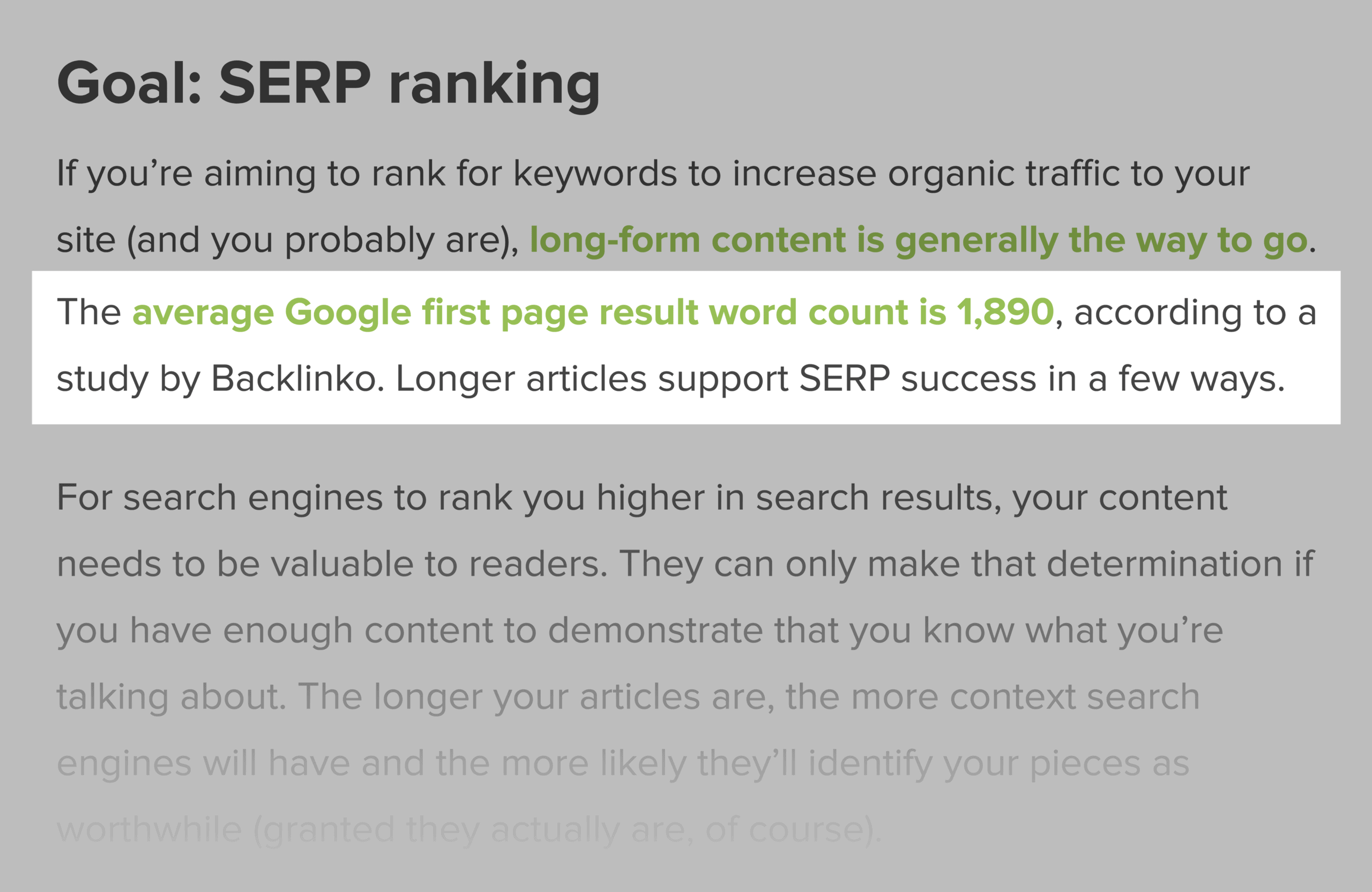
#4: In-Depth Ultimate Guides
What It Is:
A comprehensive resource that covers everything there is to know about a given topic (and then some).
Why It Works:
Ultimate guides pack an insane amount of information in one place. This makes your guide THE go-to resource for that topic.
Real-Life Example:
I used to get emails from people asking me for keyword research advice on a daily basis.
Unfortunately, I didn’t have anything on my blog that covered that super-important topic.
So I created one: Keyword Research for SEO: The Definitive Guide.
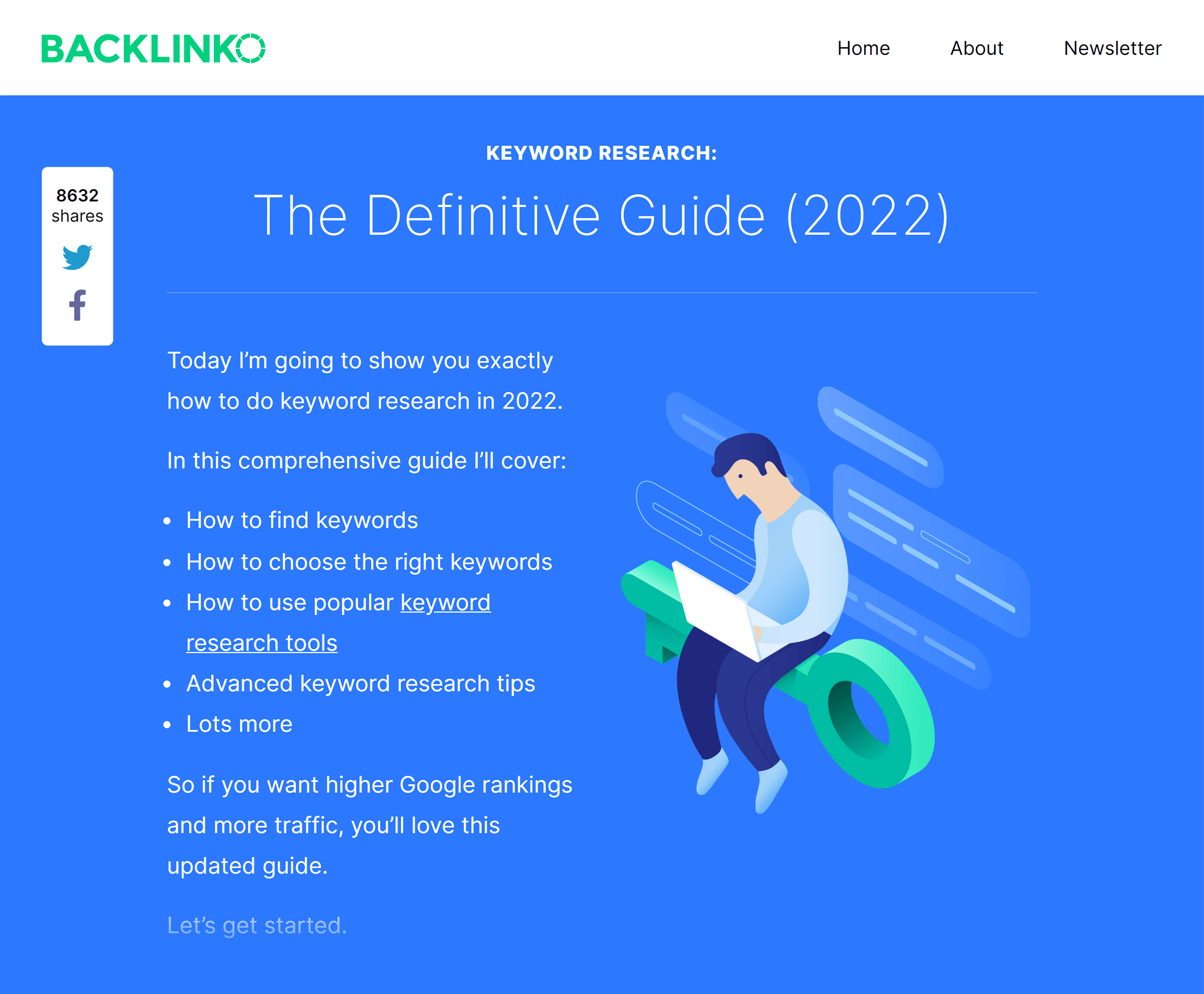
Because this multi-chapter guide covers keyword research like no other resource online, it’s been linked to over 37 thousand times.

Now that you’ve created a piece of link-worthy content, it’s time to build some links.
How?
With good ol’ fashioned email outreach.
CHAPTER 4:How to Build Powerful Links With Email Outreach

If you want to build white hat links in 2022 (and beyond), you need to use email outreach.
The question is:
How can you reach out to bloggers and journalists without ending up in their spam folder?
Read this chapter to find out.
1. Find “Likely Linkers”
As the name suggests, Likely Linkers are people that are likely to link to you.
I’ll show you a bunch of techniques for finding Likely Linkers in Chapter 6. But for now, let’s use a simple strategy to identify them: reverse engineering.
First, search for your target keyword in Google.

Grab the URL of the first result and pop it into a link analysis tool (I’m using Semrush in this example).
Next, hit “Backlink Analytics” in the sidebar and then “Backlinks”:
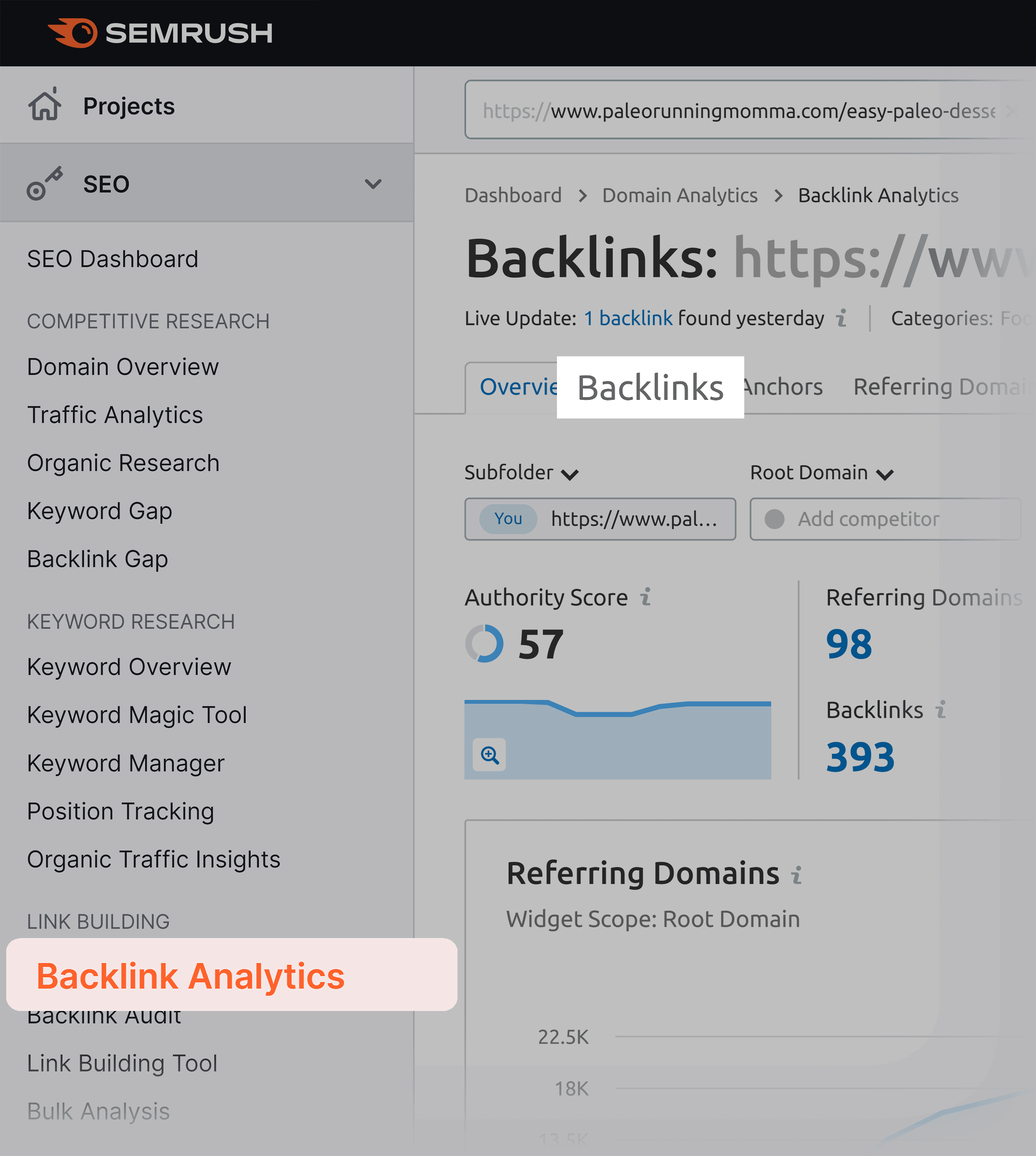
The sites listed here are all Likely Linkers.

(How do you know which sites to target and which to ignore? Check out Chapter 2).
2. Find Their Email Address
Now that you’ve found a Likely Linker, it’s time to dig for their email address.
Pro Tip: Use a site’s contact form only as a last resort. It’s a black hole.
Here’s how:
Use Hunter.io
Hunter.io is perfect for reaching out to small sites and one-person blogs.
Simply enter a site into the tool…
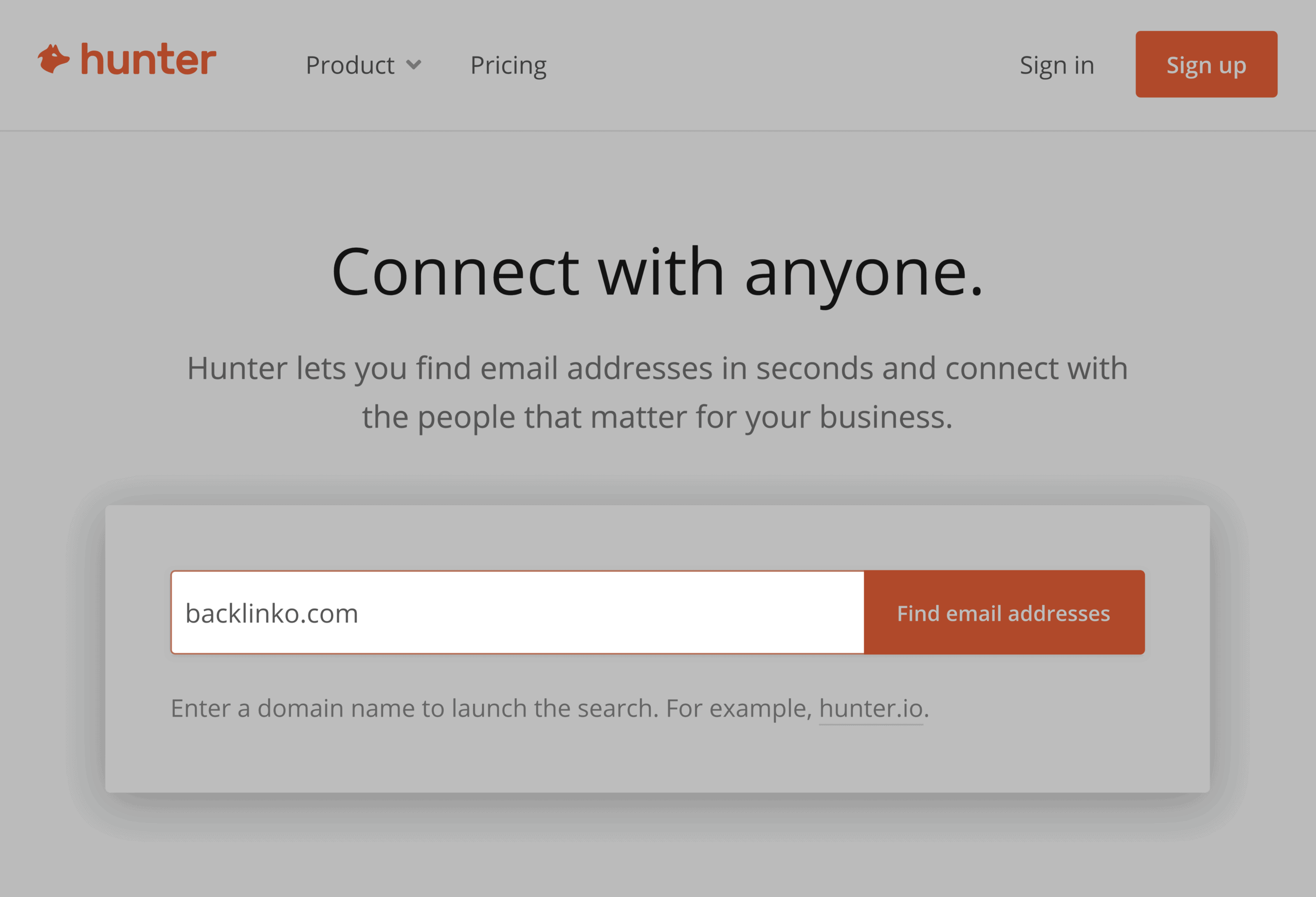
…and it’ll show you all of the email addresses associated with that domain:

But what if you want to reach out to a massive site? Combing through this list is going to be a pain.
That’s why, in those cases, I recommend VoilaNorbert.
VoilaNorbert
Instead of popping in a URL, with VoilaNorbert.com you enter a person’s name and the domain they work at.
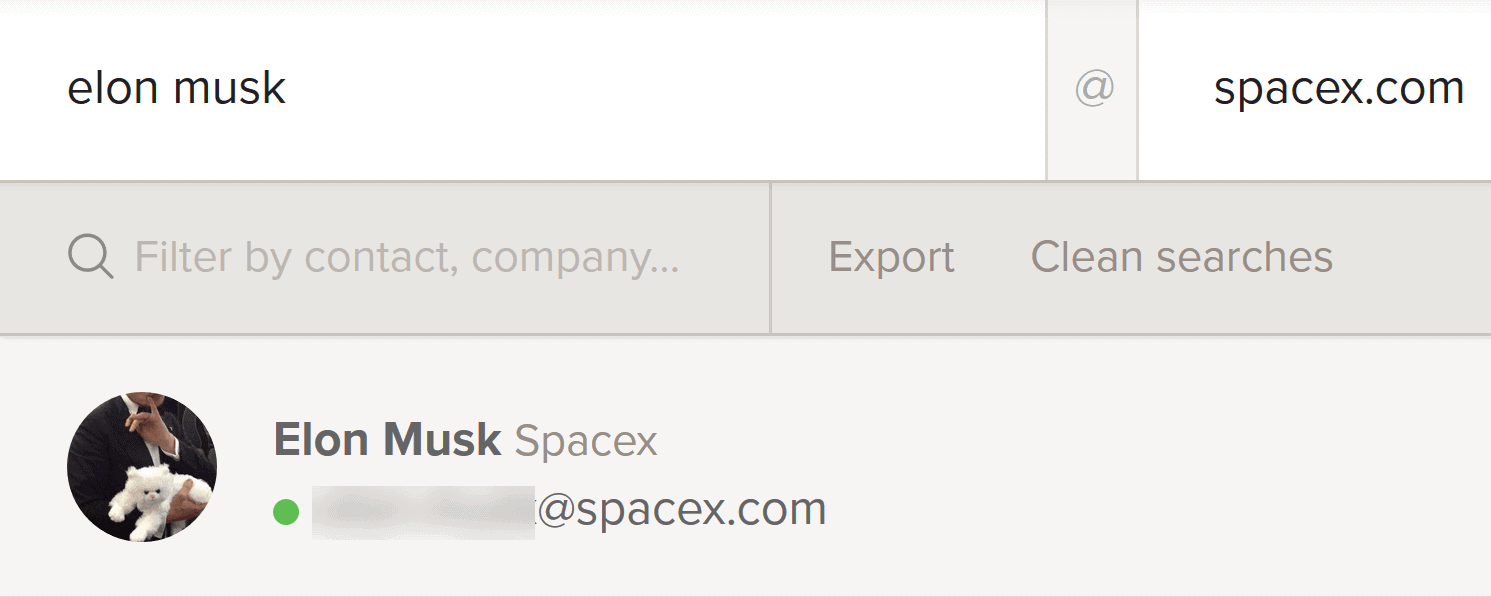
That way you’re reaching out to the person that can actually add your link to their page.
And it’ll show you that specific person’s email address.
3. Send Them a (Personalized) Script
If you want to scale outreach, you’ll need to use scripts.
The trick is to make your script not look like a script (more on that in the next step).
But now, here’s an example of one of my best-performing email scripts:
Hi [First Name],
I was looking for content on [Topic] today, when I stumbled on your article: [Article Title].
Good stuff! I especially enjoyed [Something specific from their article].
Also, I just published a new guide on [Your Topic]: [URL].
As someone that writes about [Topic], I thought you’d enjoy it.
My guide may also make a nice addition to your page. Either way, keep up the awesome work with [Website]!
Talk Soon,
[Your Name]
Notice how the script allows A LOT of personalization without a whole lot of effort.
CHAPTER 5:The Skinny On Black Hat Link Building
(and Google Penalties)

No guide to building links would be complete without a chapter on black hat SEO.
Black hat link building is pretty easy to spot: If the links go against Google’s Webmaster Guidelines, they’re probably black hat.
Does that mean you should avoid black hat link building altogether?
That’s a choice only you can make. I personally don’t recommend black hat link building (the risk doesn’t come close to justifying the reward). But it’s up to you.
That said, whether you’re a white hat or black hat SEO, you do need to know the penalties that Google dishes out.
So let’s briefly cover them:
Google Penguin
What It Is:
An algorithmic penalty that specifically targets sites that use spammy link building techniques (like shady guest posting and blog comment spam).
How to Avoid It:
Only build white hat links. There’s data to show that you can dodge Penguin by minimizing exact match anchor text (I say anchor text is part of the story…but it’s more about trust). That said, the easiest way to avoid Penguin is to avoid shady links (regardless of anchor text).
Manual Penalty/Unnatural Links
What It Is:
A manual penalty from someone at Google. Unlike Penguin, Google will send you a message via the Google Search Console:

How To Avoid It:
No one outside of Google knows how sites get targeted for manual penalties. My take is that an algorithm spots a website that’s potentially gaming the system. And they bubble that site up to someone at Google for a manual review. So the best way to avoid a manual penalty is to have a squeaky-clean link profile.
Also, unlike with Penguin, you can recover from a manual penalty by disavowing links and filing a reconsideration request.
CHAPTER 6:My Three Favorite Link Building Strategies (Step-By-Step Tutorials)

No intro needed for this chapter.
Here are 3 of my battle-tested strategies for building lots of world-class backlinks:
Resource Page Link Building
First off: what are resource pages?
Resource pages are pages that link out to awesome content on a given topic.
Here’s an example:

Because these pages exist for the sole purpose of linking out, they make PERFECT link building targets.
With that, here’s the step-by-step process:
1. Find Resource Pages
Use these search strings in Google. They’re designed specifically to unearth resource pages:
“Keyword” + inurl:links
“Keyword” + “helpful resources”
“Keyword” + “useful resources”
“Keyword” + “useful links”
2. Size Up The Page
Here’s where you (quickly) answer the question:
“Is a link from this page worth the effort?”.
(Hint: Use the tips from Chapter 2 to make this step a breeze)
For example, this resource page has a decent URLRating of 12. Not bad.
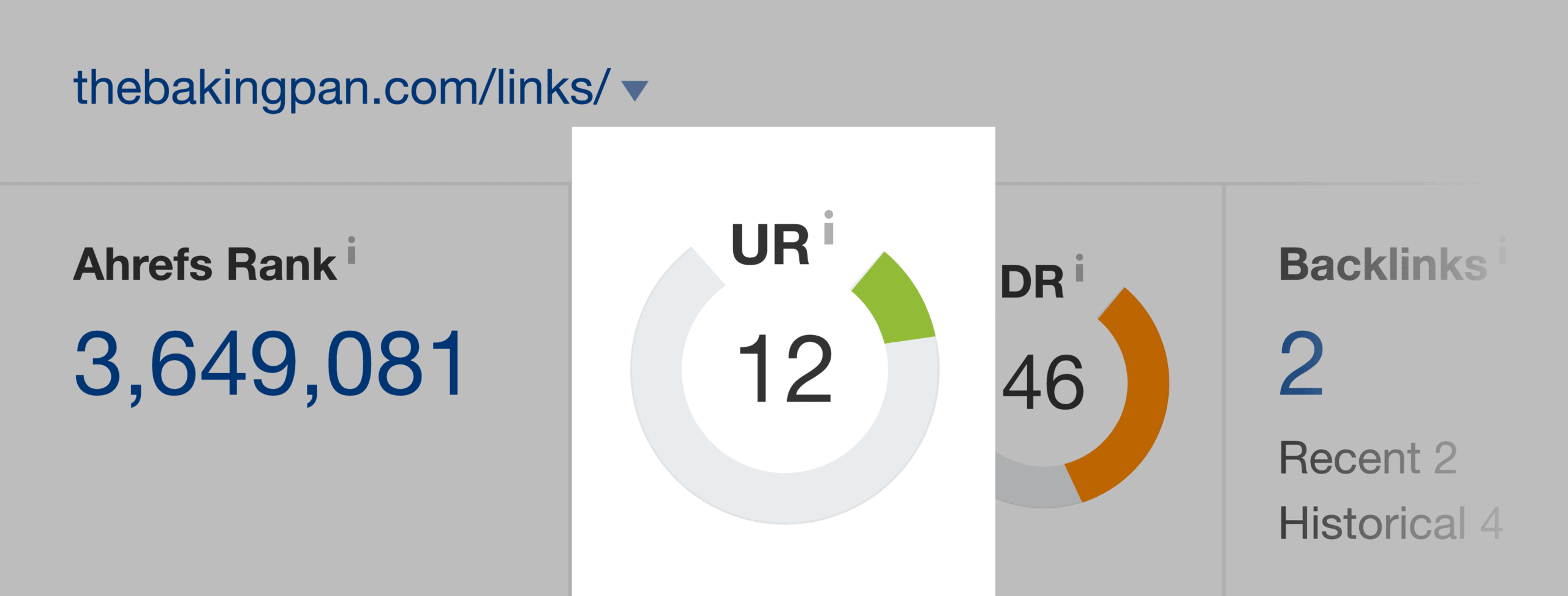
It’s also on an authoritative domain.
And my link will end up somewhere on the body of the page. Looks like a winner!
3. Find “Best Fit” Content
Look:
Your content can be the best in the world…
…but if it’s not a good fit for that resource page?
You’re not gonna get a link.
So for this step, find content on your site that’ll fit that resource page like a glove.
Once you’ve ID’d that content, move onto step #4.
4. Send This Tested Script
Here’s the script I recommend:
Subject: Question about [Their Website]
—
Broken Link Building
Broken Link Building is one of my all-time favorite link building strategies.
Why?
Instead of straight-up begging for links, with Broken Link Building, you add value to someone’s website.
Here’s how to do it:
1. Install Check My Links or LinkMiner
Both of these tools quickly find broken links on any page (from within your Chrome Browser).
I’ll show you how to use them in a minute.
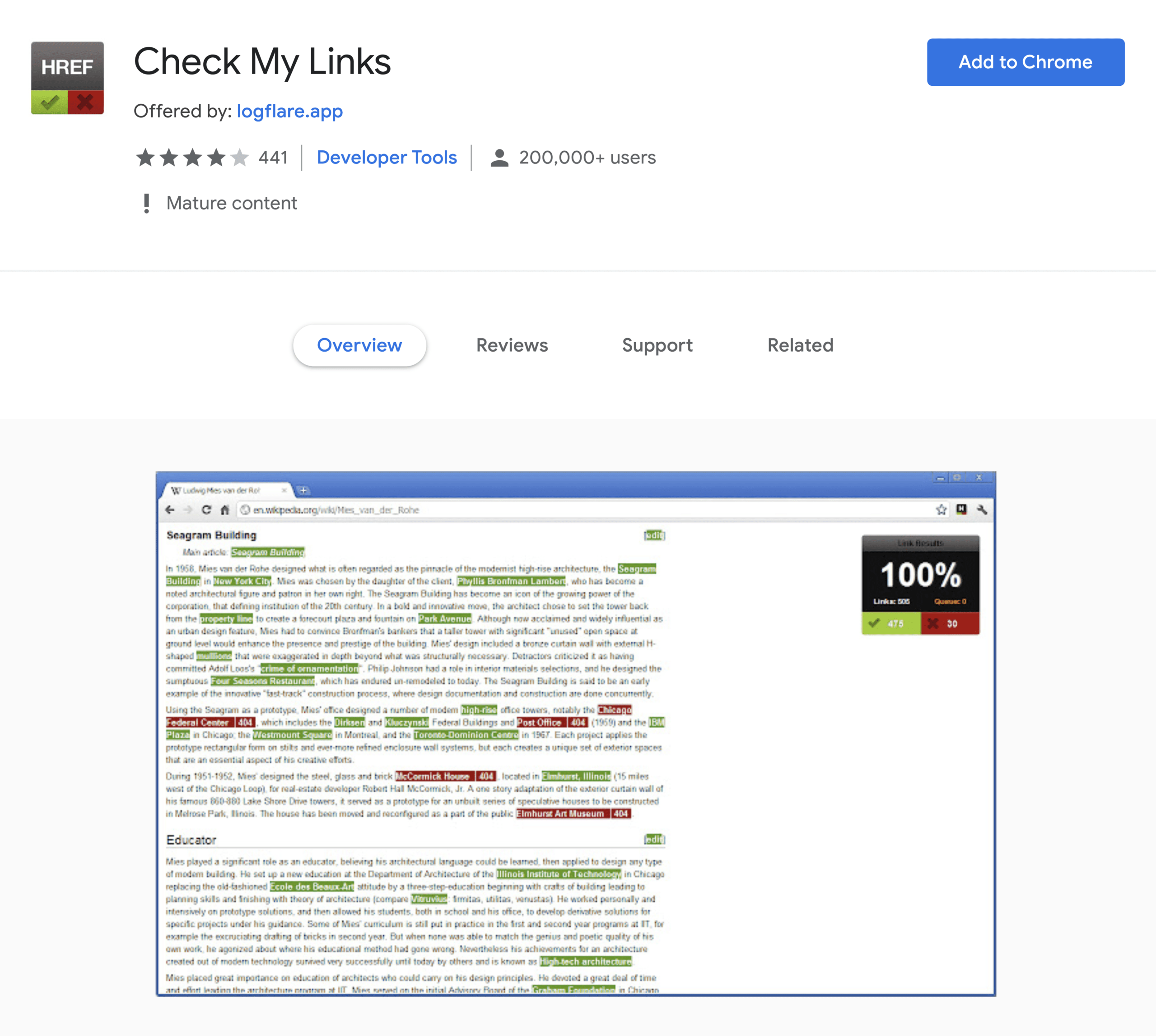
2. Find Pages With Lots of Outbound Links
The more links a page has, the more likely one of them will be broken.
Resource pages work great here. So feel free to use the search strings above to bring up resource pages.
3. Check For Broken Links
Here’s where you run the extension you installed in the first step.
They’ll reveal broken links on that page:
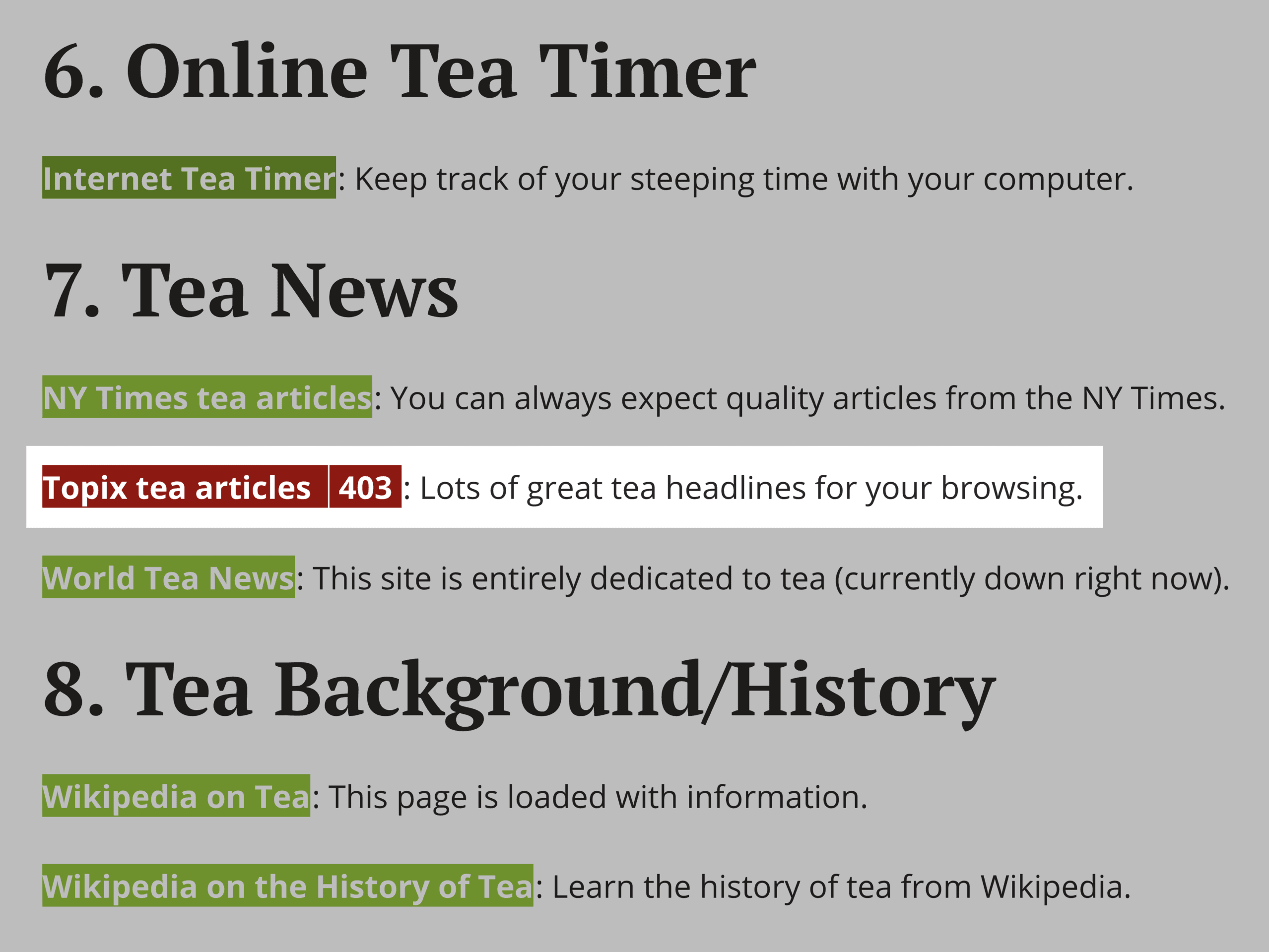
4. Email The Site Owner About Their Broken Link
Finally, let the person that runs that page about their broken link (or links),… and pitch content from your site as a replacement.
Here’s the script I recommend:
Subject: Problem with [Their Site’s Name]
—
Hi [Name],
Are you still updating your site?
I was searching for content on [Topic] when I came across your excellent page: [Page Title or URL].
However, I noticed a few links didn’t seem to be working:
[URLs of broken links]
Also, I recently published [Brief Content Pitch]. It may make a good replacement for the [Point Out a Specific Broken Link].
Either way, I hope this helped you out
Thanks,
[Your Name]
The Skyscraper Technique
This video will walk you through the step-by-step process:
Once you watch the video, it’s time for the next chapter:
Awesome link building case studies!
CHAPTER 7:Incredible Case Studies

Now it’s time for me to show you real-life examples of link building in action.
The best part?
I’ve never shared any of these case studies before.
Case Study #1
How Julie Used The Skyscraper Technique to Boost Organic Traffic By 194.1%
Julie Adams’ blog, Our Beautiful Planet, was struggling.
Sure, Julie was publishing great content. But in her words: “No matter how awesome my content was, no links came.”
That’s when Julie decided to try The Skyscraper Technique.
So instead of publishing another piece of great content…she created something AMAZING. Here it is:
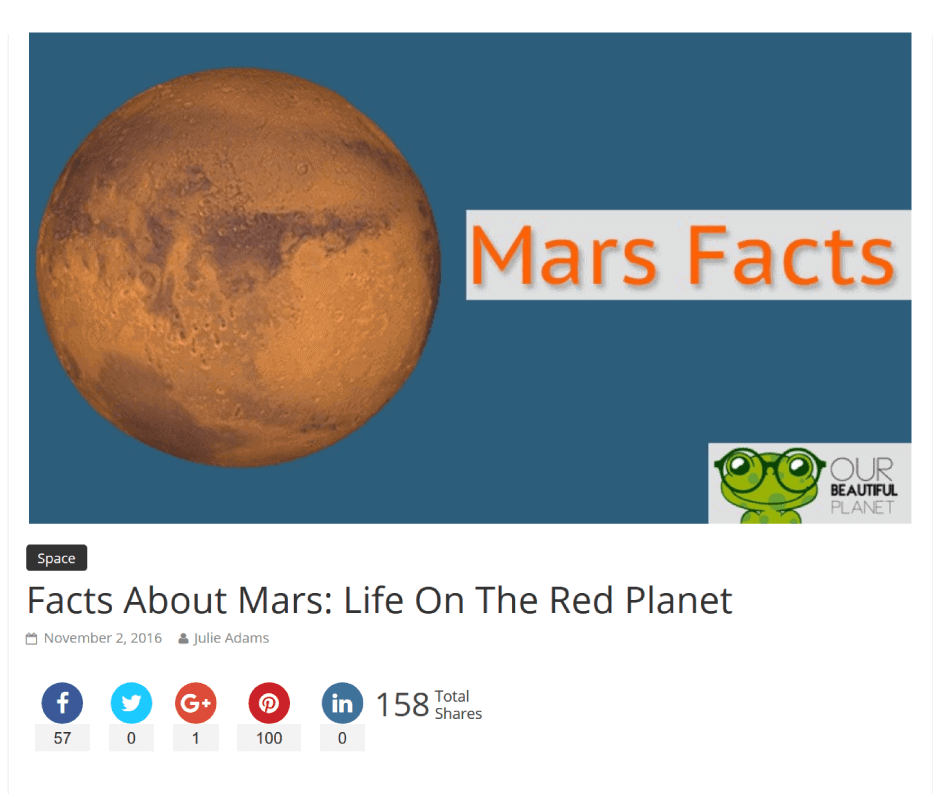
And instead of publishing this content and hoping for the best, Julie used email outreach to build backlinks.
And this landed her a handful of links from authority sites in the science space:

These white hat backlinks boosted her organic traffic by a legit 194.1%:

Why does The Skyscraper Technique work so well?
According to Julie:
“The thing that makes this so successful is that it’s just as much about building relationships as it is about building links. People won’t link to your content unless they know it exists, and they won’t know it exists unless you tell them about it.”
Well said.
Case Study #2
Broken Link Building Pays Off
Last year I decided to run a broken link building campaign. So I followed the steps that I outlined in the last chapter.
First, I used search strings to bring up pages with lots of outbound links.
And I used Check My Links to find links that weren’t working.
Then I emailed the person in charge of that content to give them a heads up about broken links that I found:
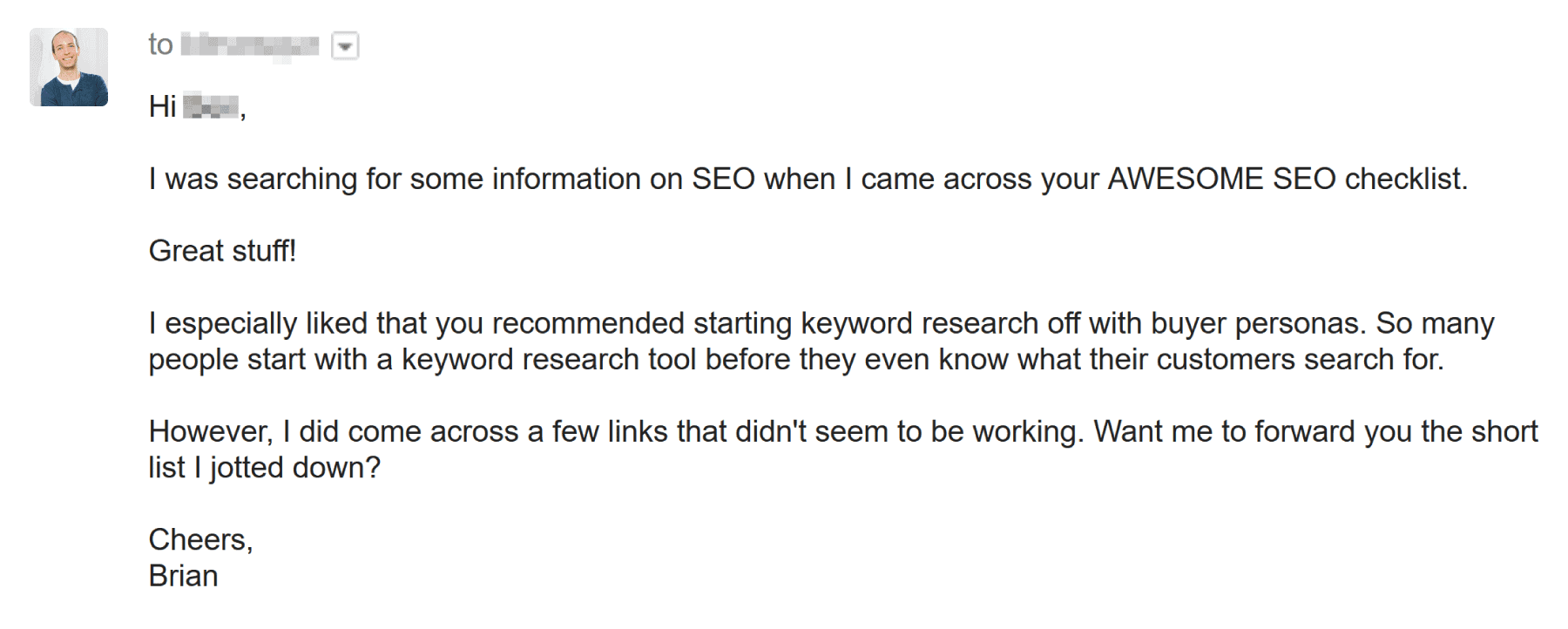
(Note how uber-personalized that email is)
When they replied, I sent them the URL of the broken link…and a piece of content from Backlinko that would be a 1:1 replacement:

And most folks were more than happy to add my link:

Case Study #3
How Matt Built Links to His Ecommerce Site
Let’s face it:
Link building for ecommerce sites isn’t easy.
But it’s possible. Just look at Matt Lawry.
Like most ecommerce site owners, Matt had trouble building links to his ecommerce website (an Australian site focused on gifts).
After all, who wants to link to a site made up of 100% product pages? That’s when Matt realized that he could use content to generate links to his ecommerce site.
Specifically, Matt published an amazing piece of Skyscraper content on his site: “Australian Gin: The Ultimate Guide”.

Of course, Matt didn’t sit back and wait for the links to roll in. He promoted his content via email outreach:
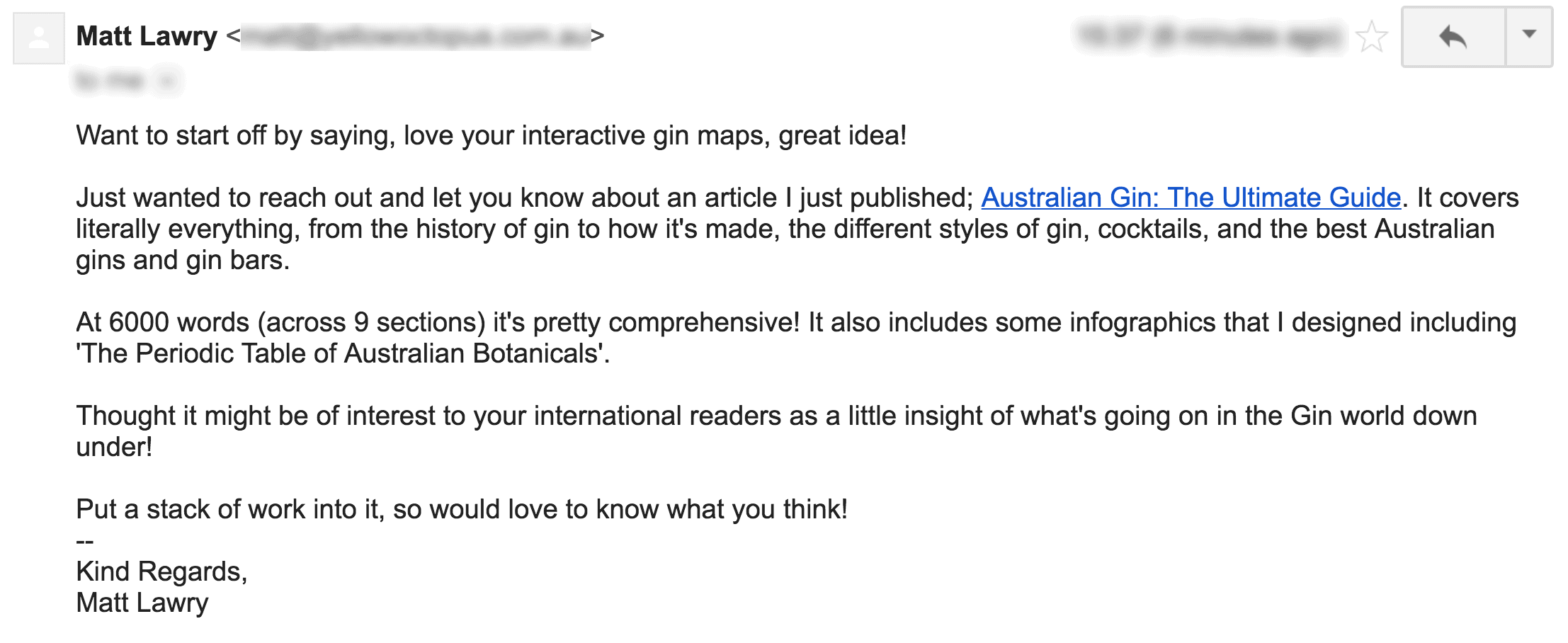
Because Matt reached out to the right people (and sent them personalized emails), many people OFFERED to link to his guide.
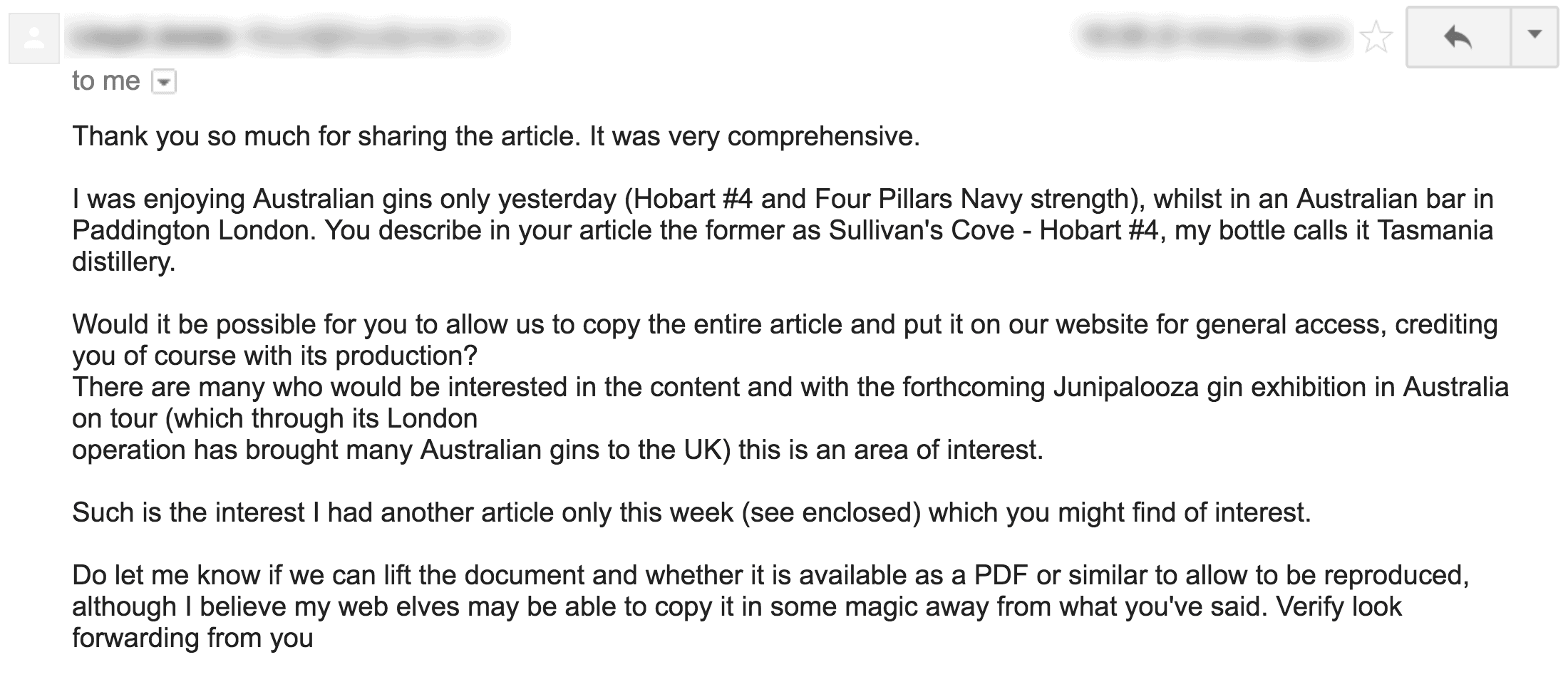
And all of these links boosted Matt’s rankings for a keyword that directly results in sales for his ecommerce site: Australian Gin.
CHAPTER 8:Advanced Link Building Tips

Here’s a quick list of advanced link building tips that I’ve picked up over the years.
Get Easy Links With Link Reclamation
Whenever someone mentions your brand in an article, they link to you…right?
Wrong.
I mean, they should link to you. But it doesn’t always happen.
Here’s what I mean:

But with a gentle nudge, most site owners are happy to turn your unlinked mention into a link.
How do you find these unlinked mentions? BuzzSumo works great.
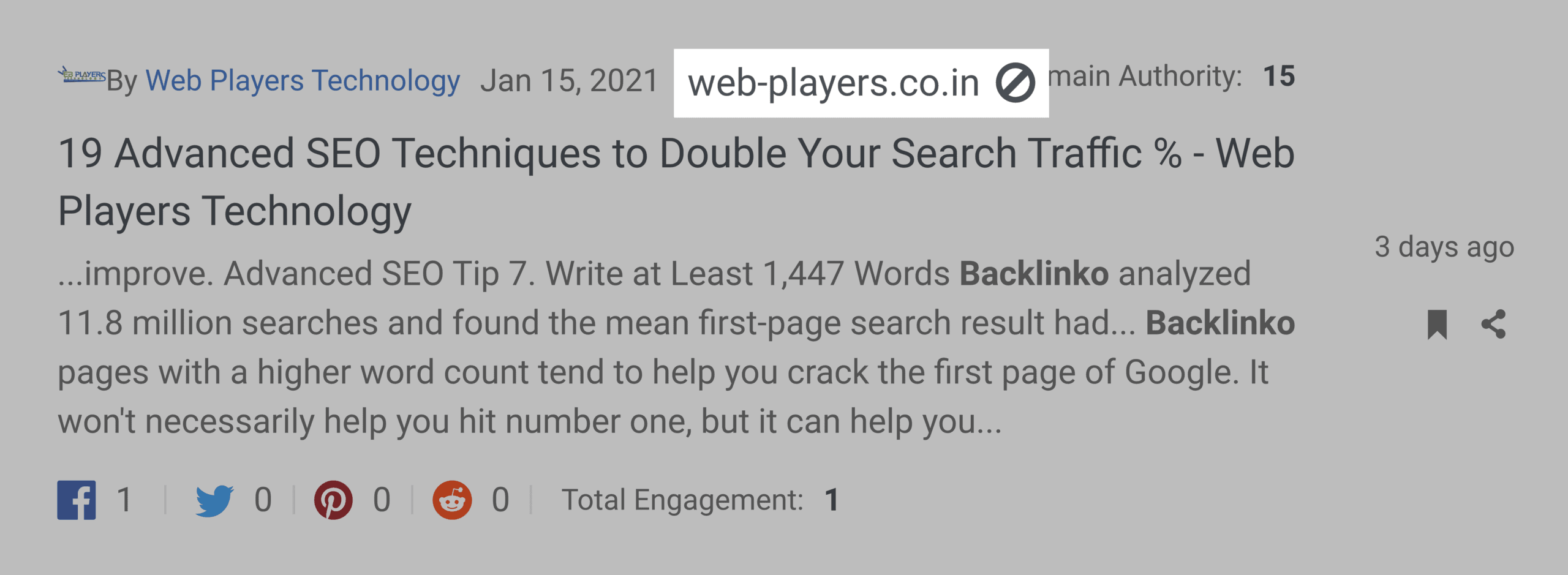
Get “Bonus” Links With Reverse Image Search
Do you publish visual assets like infographics and charts?
If so, there are probably sites using your images without attribution right now.
Don’t freak out. In fact, you should celebrate. Just like with link reclamation, a friendly email can turn many of these opportunities into links.
And you can use Google reverse image search to find peeps that are using your images without a link:

Send Emails In the Afternoon
Here’s one thing I’ve learned from sending THOUSANDS of outreach emails:
Send your outreach emails in the afternoon (in the recipient’s local time).
Why?
When you send your message in the morning, it gets lumped together with the 93 other emails that person has to deal with.
But when you send in the afternoon, there’s much less competition in the inbox.
I recommend Gmail’s built-in scheduling feature to help time your outreach emails:

Create Visualizations of Concepts, Ideas and Strategies
Here’s an example of this in action from Backlinko:

Believe it or not, but lots of people have linked to me thanks to this simple illustration:

Why does this work so well?
Well I COULD have simply described the APP formula with text. But that would have made my content much less shareable.
On the other hand, when you create a visual, you have something that bloggers will happily use in their content (and link to you when they do).













Reviews
There are no reviews yet.